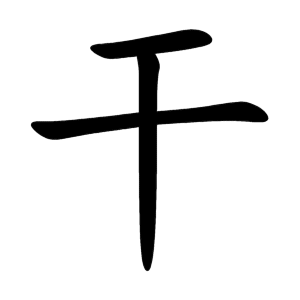干
- shield;
- dry;
- to violate;
- to interfere;
Etymology
According to Shuowen Jiezi, the character is a compound ideograph formed from an upside-down 入 and a horizontal stroke 一, symbolizing the meaning “to commit a crime.”
There are also interpretations that see it as a pictograph of a weapon and shield.
Historically, together with the twelve earthly branches (地支 dìzhī), it formed the Ganzhi (干支 gānzhǐ) system used to count days and years — see also the ten heavenly stems (天干 tiāngān).
Additional notes
Characters with 干
5 strokes
6 strokes
8 strokes
Words that derived from 干
干
방패
간
bangpae
gan
Kangxi radical:51
Strokes:3
Unicode:U+5E72
Cangjie input:
- 一十 (MJ)
Composition:
- ⿱ 一 十
